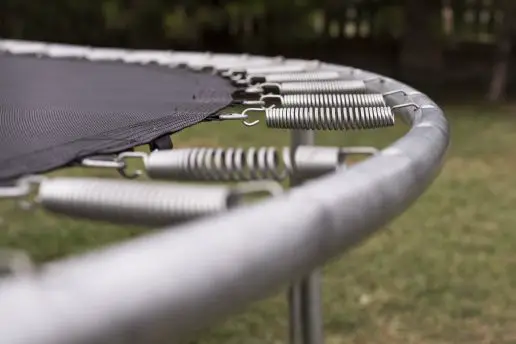Let’s be honest, trampolines are wonderful. They are popular among children. They are popular among grownups. They’re a terrific method to get the kids away from their devices and out doing something physical for a time. Furthermore, thanks to enclosure netting, today’s trampolines are fairly safe. However, there is one safety issue that is sometimes overlooked: the weight limit. Before purchasing a trampoline, you should know how much pressure the trampoline of your choosing can support.
Trampolines’ weight limits vary depending on their size, style, features, and shape. Toddler trampolines (3-5ft) typically hold 55-150 pounds. Trampolines for children and adolescents (8-10ft) can support 175-375 pounds. Full-size trampolines (12-15ft) can support 350-500 pounds.
Knowing what factors influence a trampoline’s weight restriction can assist you in deciding which trampoline to buy. It can also assist you in determining whether your children are safe while jumping on another person’s trampoline, the particular weight restriction of which you are unaware.
You can estimate the maximum weight by looking at the trampoline and utilizing the criteria listed below.
Table of Contents
Age Range and Size
When it comes to trampolines, size and age range go hand in hand. The larger the trampoline, the better for older children or adults, but also the more difficult to move. Small fitness trampolines designed specifically for adults are a clear exception to this rule.
This seems obvious given that younger children weigh less than older children. So if you look at a small trampoline that is clearly designed for one child at a time, you can be sure that the trampoline has a low maximum weight (usually 50-100 pounds).
Mat
The jumping mat, also known as the jumping pad, is another important aspect influencing a trampoline’s weight limit. The majority of mats are constructed of woven polyethylene or nylon. Close inspection of the mat reveals the individual threads weaving between and through each other.
Jumping mats with numerous heat layers of synthetic material are frequently used on trampolines with heavy weight limitations. Because this is the section that people will jump on, it must be both sturdy and flexible.
Springs

The springs of a trampoline are perhaps the most important for weight limits. The weight limit is affected by the length and number of springs. Longer springs and more flexible strings produce a bouncy surface at the expense of lower weight limitations. Shorter springs provide less bounce yet allow for a larger weight limit. The weight limit is also affected by the amount of springs. The greater the number of springs, the greater the weight limit.
Shape
The weight limit of a trampoline can also be affected by its shape. Rectangular trampolines typically have higher weight restrictions due to their design necessitating extra support.
While a circular trampoline distributes weight fairly evenly throughout the entire frame and springs, a rectangular trampoline places greater stress on the side closest to the jumper and very less load on the other side. As a result, rectangular trampolines are built to support more weight, which makes them more expensive.
Frame
The backbone of the unit is formed by a trampoline frame, which keeps all of the sections together. The majority of them are metallic, however depending on the design, some are stronger than others.
Rustproof, heavy steel frames are much more stable, making them suitable for handling higher weights. They are ideal for children because the sturdy frame would almost never break beneath their weight.
Brand
The brand/manufacturer affects the weight restriction of a trampoline to a smaller extent than the other parameters mentioned above. Not every trampoline manufacturer utilizes the same materials or designs for its trampolines. This implies that two trampolines that are the same size made by different manufacturers may have somewhat varying weight capacities.
There could be thousands of minor causes for this that only the creators are aware of. In any case, it’s best to stick to the company’s weight recommendations.
Trampolines have weight restrictions for two reasons, safety and efficient operation. These, however, are not necessarily exclusive. When it comes to trampolines, safety and correct function go hand in hand.
- A trampoline’s weight limit is a basic safety criterion. Trampoline manufacturers thoroughly test their trampolines to ensure their safety and to figure out the highest weight limit for each type. Exceeding the weight restriction is not only dangerous, but it may also cause the material to wear down very quickly, reducing the trampoline’s lifespan.
- The weight limit of a trampoline also gives instructions for proper operation. The goal is to jump around and have a good time on the equipment. However, if the trampoline is excessively heavy, the rebound required for good bouncing conditions will be limited. To get the most enjoyment of a trampoline, keep your weight under the maximum weight.
There are some risks associated with exceeding a trampoline’s weight restriction. When the weight limit is reached, physical injury can occur in a variety of ways:
- The mat has the potential to rip, dumping individuals jumping on the ground beneath the trampoline.
- Even if the mat remains intact, it can become stretched, forcing people jumping to collide with the ground beneath.
- Springs can get strained and, in rare cases, snap loose.
- The structure can be destroyed, causing the trampoline to flex inwards and collapse in two. This can result in harm and damage to the trampoline.
Regardless of trampoline size, form, or even trampoline brand, you must understand the trampoline’s weight capacity. The idea is for your children and their friends to have a good time jumping on it without being hurt.
It’s critical to get the correct weight restriction for your trampoline right away. A trampoline with a smaller maximum weight may be appropriate for your children now, but what occurs as they grow older and have growth spurts? You don’t want to have to buy another trampoline because the weight restriction is insufficient.
That is why, if you anticipate your children enjoying the trampoline for a long time, you should choose one with a greater weight limit. This way, you may be secure and utilize the trampoline without fear of exceeding the weight limit!

